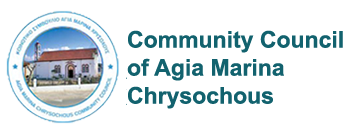History
Agia Marina is a village of Paphos. It is situated 14km northeast of Poli Chrysochous and it is built in an average altitude of 190 meters. On the west side of the village a plain lays near the sea and it is full of irrigated cultivations. The motorway of Poli Chrysochous-Pachiammos passes along this area. Before the Turkish invasion the road led to Morphou and Nicosia. The peaks and the cols of the mountains emerge on the east side of the community. Some of the slopes are full of pines and some others are completely nude, revealing the afforestation which was made in the area.
The small distance between the mountains and the sea creats a picturesque landscape.In 1965, a barrier was built near the village. It is called barrier of Agia Marina and its capacity reaches the 311.000 cubic meters. The new irrigation system of Poli Chrysochous will contribute to the irrigation of a great extent of ground.
The main cultivations of the village are citrus fruits, some vegetables, bananas and fruit trees. The population of the village in 1881 was 102 people. In 1921 the population had increased to 145 inhabitants and in 1960 they became 545. The population including the inhabitants of“Kato Yialia”, which was a village near Agia Marina, reached the 582 in 1982. The last census conducted in Cyprus showed that the population of the village had increased to 687. Almost all the people who live in Agia Marina work in other villages or cities, but at the same time they are occupied with the agriculture.
In older times, the village was situated in the area of the old church of Agia Marina near the woods. At the end of the English occupation, the English pretended that they wanted to protect the forest from the inhabitants and the animals. Thus, they convert the woods to lots and sold the land to the villagers. This is how the village was “transferred” from its first location. According to an old tradition, the plague was dispersed in the area but Saint Marina eliminated it before it killed the inhabitants of the viallge. Thus, the villagers decided to give the name of the saint to the village because she helped them to fight against the disease.
The village is known as Agia Marina Chrysochous so that it is distinguished from the other villages with the same name.

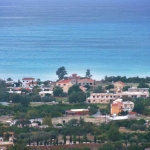
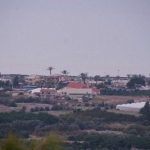
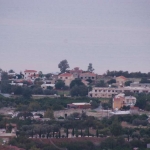
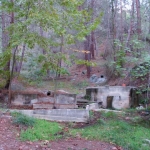
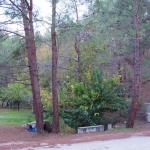
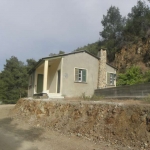
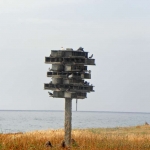
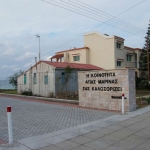
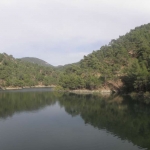
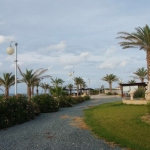
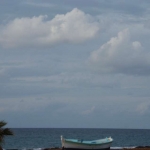
Customs
Christmas
Christmas
Some days before Christmas, all the women of the village start preparing for the big feast.
The preparations included cleaning of the house, dusting, cleaning of the furniture, cooking of rusks in the traditional mud ovens, painting of the houses and the of the external wall and fencing.
On Christmas day, people went to church. After the service they receive communion (“paskazei” in the Cypriot dialect) and then they exchanged wishes and kisses.
Thereafter, they return to their homes and the entire family sat on the table for the traditional soup “avgolemoni” (made of eggs, lemon and rice) or trachana, in a pleasant environment.
The period from May to June, they bought pigs and raised them until Christmas. Then, they butchered them and with its meat they made lountza (traditional smoked ham), sausage and minced meat. With its tummy, they made dry-salted meat (pasta) and with its feet and head they made “zalatina” (a kind of brawn). The sausages were dipped in wine and then they were exposed to the sun. The other parts of the pig, were semi-cooked and kept in “koumnia” (clay pots) with all their fat, which melted after cooking. This way they had supplies for a very long time.
New year’s day
On New Year’s Eve, the housewives would prepare Vasilopitta (traditional pie) and put a coin in it. The pie would be cut in the afternoon of the New Year’s Day. The person, who would find the coin, was considered the luckiest person of the year.
On New Year’s Day people went to church to attend to the service and when it was finished they exchanged kisses and wishes. The first day of the year, after the church, when people returned to their homes they traditionally stepped in with their right foot. It was believed that this would bring good luck for the rest of the year.
They also played cards in coffee shops and in different houses. This custom survives to this day.
Epiphany
On the day of the epiphany, all the housewives made “loukoumades” (fried honey puffs) and ate them with their families. One old tradition said that “kalikantzaroi” (goblins) came to the village and roamed at night scaring the people. So, women threw some “loukoumades” on the roofs of their houses believing that “kalikanztaroi” would eat them and leave the village quietly.
After the service, the priest of the village accompanied by a child, went to all the houses and hallowed (sprinkled with holy water). The owners of the house offered them sausages, lountza, zalatina and wine.
Lent Period
The lent period begins on the Sunday of the Prodian Son and continues till the Sunday of “Tyrofagos” (last day of the Carnival).
Usually during this period, a lot of people masqueraded and went to friendly houses where they amused the owners.
On Clean Monday (or Shrove Monday), the inhabitants went in the fields to celebrate the day, eating Lenten food.
Easter
Customs of Easter
The days before Easter all the houses were cleaned out and cooked the traditional rusks (arkatena) and the famous “flaounes” (pastry with cheese and raisins). On Holy Thursday the painted some eggs, usually red, which they would clink after the Resurrection Ceremony.
Saturday of Lazarus
On Saturday of Lazarus there is only one service in the village’s church and all the inhabitants attends to it, chanting hymns.
Palm Sunday
On Palm Sunday, women took leaves from olive trees to the church. The leaves would remain in the church until Pentecost when they would be hallowed and taken back home for the traditional “kapnisma” (literally smoking). Specifically, the leaves from the olive tree were put in the “kapnistiri” (earthen-plated vessel) with cinder and used for the “kapnisma” of the houses and people. This practice is considered as apostrophic for the evil spirits and it survives to this day.
On Holy Thursday, the holy icons of the church are covered with a black veil indicating the bereavement of the faithful. The same night, a replica of the holy cross with Christ on is set. On the right of the cross there is a replica of Apostle John and on the left another replica of Virgin Mary.
All the habitants of the village go to church and genuflect before the holy cross and attend to the service of the 12 gospels concerning the Passion of Christ, His Crucifixion and His death.
On Holy Friday the faithful decorates the epithaph. In older times the decoration was done after the mass of Holy Thursday. Young men and women chant the dirge (lamentation), while three myrrh-bearing women strew the epitaph with myrrh, aromas and flowers. After the service the people stay in the church and chants the dirge of the Virgin Mary.
During the morning service of Holy Saturday, when the priest says “Anasta o Kirios” (Arise, O God), the faithful slam the church’s stools and the black veils, which cover the holy icons fall.
Around 11 pm, the bells toll merrily in order to invite the Christians to the happiest service of the Christian church.
Outside of the church there is a big fire, called “Lampratzia” (eastern bonfire). At midnight the priest says “ defte lavete fos ek tou anesperou fotos” (come forward and receive light from the eternal light) and comes out of the church with the lay clerks for the Procession. People light their candles from the holy light and they all go in the yard of the church for the Resurrection Ceremony.
After the service, people return to their homes, with their candles and keep the holy light for 40 days. They eat the traditional soup “avgolemoni” (made with eggs, lemon and rice) or trachana, flaounes.
On Sunday, they make the traditional lamb on charcoals and they celebrate the day.
Traditional Wedding
“Proxenio” (match-making)
The matchmaker, a relative, or a close friend of the bride’s family made the Proxenio”. A good groom was considered a man, who was rich, from a good family and diligent. If the groom came from another village, the parents of the bride went to his village and asked his fellow villagers for any information they wanted to learn about him or his family. Most of the times, the girl’s opinion was not taken into consideration.
Betrothal (logiasma)
Close relatives such as the groom and bride’s godparents, uncles and aunts, grandparents, brothers and sisters and the priest of the village were invited in the pre-engagement. The priest would prepare the prenup, which had legal validity. In the prenup the parents noted the marriage portion that they would give to their children. After the pre-engagement, there was a big party with plenty of food and songs.
“Engagement”
Only a few people were invited in the engagement. The relatives exchanged handkerchiefs and rings. The house of the couple was built or given by the bride’s father. The construction of the house was not an easy job as it was built with stones, which were collected and transferred usually by the close relatives and the builders.
Preparations for the wedding
The invitations were given one month before the wedding day from the groom and the best man with a special procedure that included handkerchiefs and for the close relatives handkerchiefs and shirts.
On Saturday the relatives “sewed” the bed. The festive atmosphere included violins, lutes, dancing, songs and “tsiatista” (traditional songs). The couple’s bed was filled with pure sheep’s wool and it was sewed by 5 or 7 women (who were married only once). During the sewing of the bed, the other relatives sang and the musicians continued playing. The bridegroom’s relatives put money on the bed (plumisma) as a gift for their wedding.
The fathers of the bridegroom begun the “dance of the bed sheets”, then the best men and the mothers of the bridegroom continued.
Thereafter, the groom’s closest friends and his best men danced (dance of the bed). Just before this dance, a young boy or girl was put on the bed of the bridegroom. People believed that if they put a boy on the bed, the first child of the new couple would be a boy and if they put a girl, then they would have a girl.
Sunday (wedding day)
Dressing of the bride
In the afternoon of the wedding day, the relatives of the bride were gathered in her parents’ house for the bride’s preparation. The bridesmaids helped her wear her wedding dress, put her make up and jewels and make her hair, accompanied by musicians who played violin and lute. Then, her parents passed along her waist a red belt and they gave their bless for a happy married life.
The shaving of the groom
The early morning of the wedding day, the groom’s clothes were transferred form his parents’ house to the new house of the couple.
The shaving of the groom took place in his parents’ house and it also included his dressing. The barber of the village, accompanied by violins, shaved him and his best friends combed him. The best man dressed him: shirt and costume, and in the meanwhile he sang with the other relatives, traditional wedding songs.
After the wedding and on the way to their new home, the couple was blessed by the neighbors who held “mereha” (bottle where they kept perfume) and “kapnistiri”. Later on, the couple stayed alone in their new home while the other relatives were celebrating.
Monday after the wedding
On Monday after the wedding day, there was another feast where all the friends and relatives celebrated and they offered their gifts to the married couple. Thereafter, the couple danced and all the guests put money on their clothes (plumisma).
Tuesday after the wedding day
On Tuesday after the wedding day the relatives took chicken from the fellow villagers, they butchered them, cooked them and ate them altogether during a big party.
Development
The small village of Paphos, Agia Marina Chrysochous, emerges from a beautiful landscape. The nature has offered generously its finest colors, the deep blue of the sea and the green of the trees. The visitors, which become more and more each year, enjoy the nature by walking in the trails. They can spend their night in various resorts which are built or planned to be built in the village. The tourist development is supplemented with the residential development as many modern villas are built in order to accommodate the tourists. Below we will give some information concerning the development of the village.
During the last years there is an apparent interest by a great number of tourists, for the discovering of the natural richness of Agia Marina Chrysochous, as it is full of characteristic samples of the Cypriot nature. The tourists arrive usually in groups or even individually, and their basic destinations are the two nature trails, which lead to the most beautiful parts of the village.
The first trail was designed and prepared by the Forest police and it is 4 km long with plenty of signs, which guide the visitors to various beautiful destinations in nature. The second trail is also easily accessible and it leads to the barrier and to the chapel of Agia Marina. The characteristic element of the trails is nature which charms all the visitors with its amazing odors and colors.
The visitors can spend the night in the tourist resorts. There are already fifty flats for rent in the village, which offer hospitality, tranquility and relaxation to the travellers.
We should also mention that the tourist resorts are expanding every year due to the love of the inhabitants for their homeland and their efforts for a greater tourist development. During the last years, an increased residential activation was noted, and it contributes to the tourist development and improvement. To be more specific, the inhabitants have started to build many villas for the tourists who ask for a more comfortable and quite place to stay. These villas are surrounded by trees and plants in a tranquil environment.
The appearance of the company “Aristo Developers” in the village, declares that the upward development of the village will be continued in the future. This company has bought land in the residential and in the non-residential zone of the village and this shows that in the near future the tourist development will increase.
The community also sets some goals for the developmental progress of the village. For example, one of the main goals is the preparation and exploitation of the wild gulf. For that reason, the community takes into consideration the studies of some competent bodies (such as the research center of the National Technical University of Athens) and encourages the creation of marine projects which will upgrade the area. It also hopes that the coastal belt of the village will be properly exploited and developed, thus it has assigned the design of several projects, such as a park and a pedestrian precinct.
Agia Marina Chrysochous is one of the villages of Paphos where the tourist and the residential development are growing in parallel and due to the incredible natural beauty of the village, which emerges from the green hills, the characteristic flora and the wild sea.
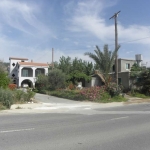
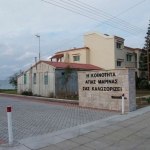
Education
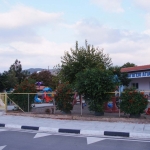
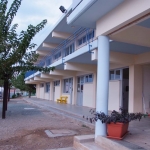
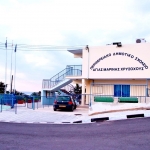
Natural Environment
The village emerges from a beautiful landscape, made of the most tranquil colors of nature: blue and green. Nature had offered to the village a unique beauty, which is consisted of the wild vegetation and the clean sea. The natural beauty is harmonically interrupted by the cultivated land which draw water from the barrier of the village. The visitor can approach the beauties of the village through two trails that pass across the village. Let’s start our tour from the natural environment.
The biggest part of the village is covered with wild flora which is enriched by Afforestation and cultivated plants. The view from the east part of the village is amazing. Green dominates the woods and it calms the visitor. The entire village is dressed also in green due to the great number of pines and the “rasi” sample of the local plantation. Many of the houses in the village are surrounded by big trees, as the mayor notes.
The west part of the village is decorated by cultivated land which is mainly irrigated by the barrier. The main cultivations of the village are vegetables, cereals, citrus and fruit trees and forage plants.
The irrigation of the cultivated land is completely depended on the barrier of the village. The river Xeros which is 2,5 km away from the sea, supplies the barrier with water. Its height is thirty-three meters, its length is one hundred and sixteen meters and its capacity is sixty cubic meters (300,000 tons of water). The barrier covers the needs of one thousand and five hundred scales of land.
The natural and technical beauties of the barrier are filled with the wild flora that dominates the village. In Agia Marina Crysochous you can meet the wild animal “Ovis gmellini ophion” (agrino), which is found only in Cyprus and it looks like a wild sheep. It is a unique and also a rare animal, thus its hunting is strictly forbidden. At the same time, you can find many more samples of the Cypriot fauna, such as the partridge.
As we mentioned above, you can approach the beauties of the village through two trails. The first one is made by the forest police and it is 4 km long, full of wild plants. The second trail leads to the barrier and to the chapel of Agia Marina.
The river banks embrace the sea and create a unique contradiction with the wild plantation and the flora. The beach of the village lays for 2,5 km. The natural wildness of the landscape will definitely charm the visitor.
Without any doubt, nature has offered generously its finest colors to this small village of Cyprus. The wild fauna and flora, the cultivated land, the beach, the barrier and the nature trails are joined harmonically and they create a unique piece of art.
The route from Poli Chrysochous that leads to Agia Marina is considered as one of the most picturesque and beautiful routes of the island. The road is straight and the view of the deep blue sea on the left side of the road is incredible. On the right side there are many trees and plants that will amaze you. We recommend you to stay in the area and enjoy the astonishing sunset. The red and gold of the sky meet the blue color of the sea creating a beautiful atmosphere. Only if you visit the village in person, you will realize the beauty of the landscape.
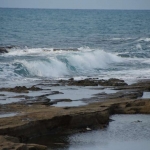
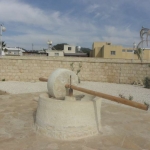
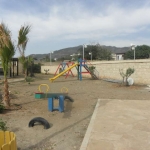
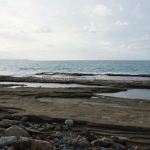
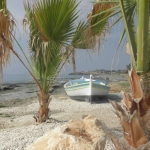
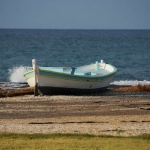
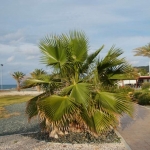
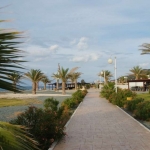
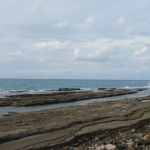
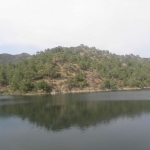
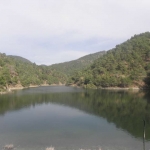
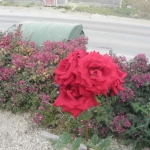
Projects
Completed
The Community Council of Agia Marina Chrysochous within the efforts to improve the quality of life of the habitants has executed some embellishment and infrastructure works.
Some of the most urgent and serious works, which have been done, are the following:
- Abolition of the waste disposal and rehabilitation of the area in its previous condition.
- Alteration of the water distribution and supply system.
- Construction of three perforations with potable water, which will cover the needs of the entire village.
- Alteration of the lighting in the high way of Agia Marina-Poli Chrysochous with new high performance lamps.
- Naming of the streets and enumeration of the houses in the community. Hiring of a postman.
- Asphalt course of all the roads of the village.
- Repair of the rural roads.
- Equipment for one more perforation and construction of a water tank in a higher place, in order to cover the needs of the entire community.
Scheduled
The Community Council continues the efforts to make the community a modern and pleasant place, and for this reason, it has already programmed the following projects:
- Town planning licenses are already given for the construction of buildings, which will include offices for the needs of the Community Council, a conference room and a storehouse.
- Creation of a park in the area of the old football field, which is near the sea. An amphitheatre (capacity 500 people), an open air space for events (capacity 3000 people), a playground, a kiosk, a shower, a vestry and toilettes for the bathers will also be constructed. The area will be enriched with parking spaces, green spaces, benches, lighting etc.
- The research concerning the road network is almost completed.
- It is the first village in Paphos, which will implement the master plan.
- Two beaches will be created. A road especially for bikes and a pedestrian precinct will be constructed. Its length will be 10 km.
- Road enlargement and lighting from the elementary school to the football field and the vicinal village “Yiallia”.
- Road enlargement in the main road leading to the elementary school. This project also includes the construction of pavements and a rainwater collection system.
- Finding of state land for the segregation of building plots for poor families.
- A nature’s path is planned to be made in collaboration with the community of Gialias.
- Finding of space to accommodate the Youth Centre.
- Reactivation of the Game Association.
- Reactivation of the Youth Centre.
- Webpage upgrade.
Useful information
| Services | Phone number |
| Thanasis Agathocleous (President) | 99643721, 26342510 |
| Father Andreas Michael (Priest) | 99546232 |
| Poli Chrysochous Police Station | 26806284 |
| Gialia Forest Station | 26812730 |
| Coop (Cooperative Credit Society) | 26342286 |
| SEDIGEP | 26342285 |
| Coop (Supermarket) | 26342287 |
| Primary School | 26342405 |
| Foinikas Athletic Club | 99613093 |
| Community Infirmary | 99643721 |
| Poli Chrysochous Hospital | 26821800 |
| Citizen Service Office | 26821888 |
| District Agricultural office | 26306260 |
| Water Development Department | 26306272 |
| Paphos Constabulary | 26806050 |
| Pafos Government Phone Numbers | |
| District Labour Office | 26306231 |
| Social Welfare District Office | 26306240 |
| Social Security District office | 26306233 |
| District Administration | 26801200 |
| Land Registry District Office | 26802300 |
| Department of Town Planning and Housing | 26811580 |
| District Tax Collection Office | 26606205 |
| Inland Revenue District Office | 26802100 |
| VAT Service | 26306314 |
| Education and Culture District Office | 26932107 |
| Public Works Department | 26801519 |
| Department of Electrical and Mechanical Services | 26801405 |
| Department of Postal Services | 26306220 |
| New Paphos Hospital | 26803100 |
| Cyprus Telecommunications Authority CYTA | 26706230 |
| Cyprus Tourism Organisation | 26423161 |
